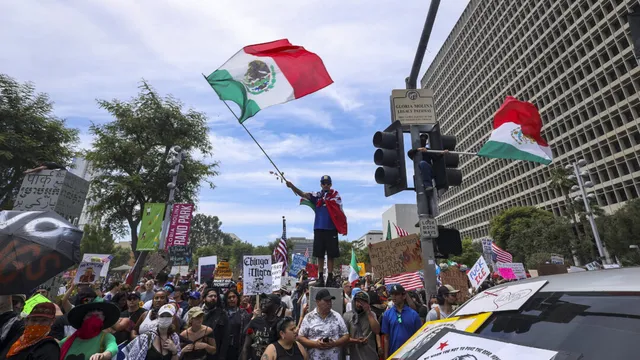
Mayor lifts curfew in downtown Los Angeles after protests
2025-06-18 07:06- Protests against Trump administration immigration raids began in Los Angeles on June 6.
- A curfew was imposed on June 10 to address incidents of looting and vandalism.
- The curfew was lifted on June 18 following reduced violence and successful crime prevention efforts.
Express your sentiment!
Insights
In response to protests against immigration policies and the deployment of additional federal troops, a nightly curfew was established in downtown Los Angeles. On June 10, the mayor implemented this curfew to mitigate incidents of vandalism and looting that accompanied the protests, which began on June 6. The demonstrations, primarily concentrated around government buildings, were spurred by the Trump administration's immigration raids. On June 16, following a reduction in violence and crime, Mayor Bass announced a reduction in curfew hours, moving its start time to 10 p.m. and ending at 6 a.m. By June 18, the mayor officially lifted the curfew, citing its success in crime prevention and community safety. The protests erupted in Los Angeles, a heavily Latino city in California, as a reaction to President Trump's aggressive immigration policies, notably the raids targeting undocumented immigrants. These policies sparked fear within the community, leading to a series of rallies that initially remained peaceful but escalated into clashes with law enforcement due to the heightened security measures, including the deployment of around 4,700 National Guard troops and Marines directed by the federal government. The mayor expressed concern over the disproportionate fears experienced by locals, emphasizing that people should not have to fear for their freedom in public spaces. The curfew was initially described as necessary to curb violence after several instances of vandalism and looting during the first few days of protests, where approximately 23 businesses experienced break-ins. It encompassed a one-square-mile area in downtown Los Angeles, aimed at maintaining order amidst the chaos. However, following a series of calm nights and a significant drop in arrests, Mayor Bass decided to adjust the curfew, reflecting the improved situation. This adjustment was welcomed by residents and business owners affected financially by both the curfew and previous vandalism incidents. Despite the lifting of the curfew, the mayor did not indicate a future plan for the complete cessation of enforcement measures against violent protesters, as safety remained a priority for her administration. Business owners expressed concerns over the lengthy impact of the disturbances, particularly due to considerable damage inflicted upon their businesses during the unrest. The mayor vowed to continue to monitor the situation closely and take appropriate actions, making the commitment to reestablish a stable and secure environment in Downtown Los Angeles as critical to both community and economic revival.
Contexts
On June 18, 2025, Karen Bass's immigration policies and the public responses to them came under scrutiny as protests erupted in major cities across the nation. These protests were fueled by various stakeholders who expressed concerns over the perceived impact of Bass's immigration approach, especially in relation to undocumented immigrants and their communities. Advocates for immigrant rights voiced strong opposition, arguing that the policies implemented under Bass's administration have contributed to increased fear and insecurity among already vulnerable populations. They claimed that the policies were reminiscent of stricter immigration laws that many believed would stifle opportunities for immigrant communities rather than support their integration and success within society. The protests demonstrate a significant level of public discontent regarding how immigration policies are being crafted and implemented. Activists organized several marches, rallies, and public forums not just to oppose the current policies but also to advocate for a more humane approach that would prioritize family reunification, provide pathways to citizenship for migrants, and ensure that basic human rights are upheld. The demonstrators included a diverse group of individuals, from undocumented immigrants themselves to allies from various socio-economic backgrounds, highlighting the widespread sentiment that immigration reform must not only be thorough but also compassionate and just. In response to the mounting pressure from these protests, Bass's administration has made attempts to address the concerns raised by activists and immigrant advocates. Official statements have emphasized a commitment to reforming immigration processes, improving conditions in detention centers, and increasing support for asylum seekers. Nevertheless, the effectiveness and sincerity of these responses have been questioned by critics who argue that mere rhetoric is inadequate to effect meaningful change. Many protestors have called for accountability in how policies are developed and enacted, insisting that the voices of those directly affected be incorporated into future discussions surrounding immigration policy. As the situation continues to evolve, it remains clear that immigration policy will be a pivotal issue in national discourse. The protests serve as a reminder of the complexity of immigration issues and the necessity of creating policies that reflect the values of equality, justice, and respect for human dignity. The long-term ramifications of these policies, along with the sustained public pushback, will likely influence not only Bass's political standing but also the trajectory of immigration reform in the United States.